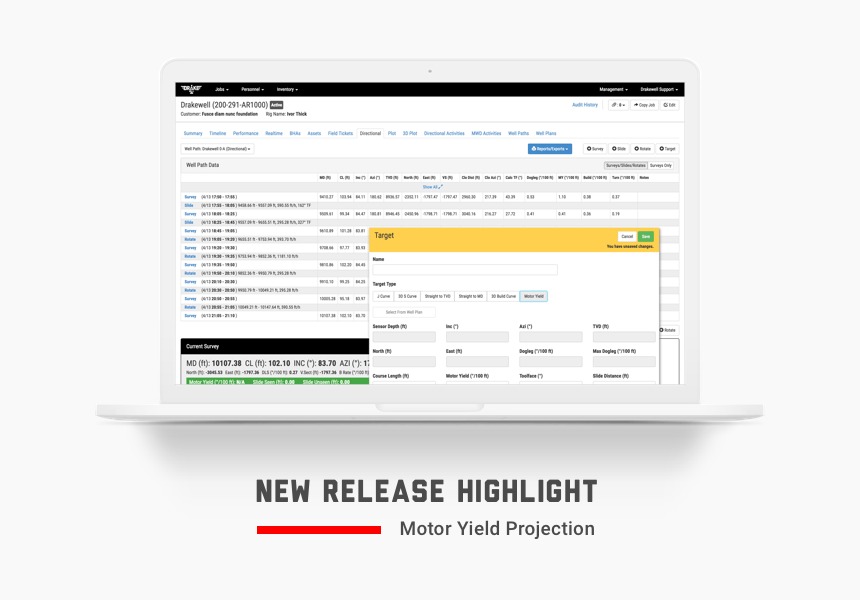
We recently added a powerful new projection to our list of available Target projections in the Drakewell directional drilling feature. By listening to your feedback and working closely with industry leaders and directional drillers we’re confident you’ll find it to be a useful navigation tool during drilling operations. Here’s why we think you’ll love it.
What is Motor Yield
The motor yield projection is a powerful new projection type which adds more flexibility to a Drakewell directional driller’s toolbox. By entering the Course Length, Expected Motor Yield, Expected Toolface, and Expected Slide Footage, Drakewell will calculate where you will land if those parameters hold true. This projection is similar to a ouija board.
Like the other projection types in Drakewell you can combine this with other targets by stacking them and you can take advantage of Drakewell recalculating your projected path automatically after each new survey is entered.
Why Motor Yield is important
The Motor Yield projection has been in high demand amongst drillers and ops managers. This projection gives you the ability to simulate a variety of scenarios including:
- A custom projection to bit
- Holding at an expected motor yield through a particular formation
- Estimating where the you will be if you have less than expected motor yield
- And more
How you can leverage the Motor Yield
For projecting based on estimated motor yield
In many cases, the motor is giving a higher or lower build than the theoretical calculations are telling us. As you’re landing a curve, for instance, you may be holding a particular build rate but you know that as you level out your motor will fall off more quickly than calculations based on surveys and slides will tell you. This is a great scenario for the Motor Yield projection method.
Like other projections Motor Yield can be stacked above or below a series of other projections. This can be used to anticipate a series expected targets. If you want to see where you’ll end up if you hold a 30° L toolface at your current motor yield for 100 feet, then adjust your motor yield for an upcoming formation for the next 200 feet, you can stack two Motor Yield projections. If you want to hold straight for that next 200 feet instead, you can stack a Motor Yield projection and a Straight to MD projection.
Another great scenario is to build tangents (similar to the above example). If you kick off and getting higher than desired build rates, it’s important not to simply drop build. Instead, set a Motor Yield target to build a tangent a tangent out a few hundred feet holding the build rate you’re getting. Then stack a 3DS to help you ease back down to land the curve.
For entering custom projections to bit
Drakewell projects from the last survey in a well path. With this new projection type you can now place a Motor Yield projection as your top projection in a stack. This will allow you to stack projections under it giving you the ability to do projections from the estimated bit location.
In addition you can use this feature to create a stand alone projection to bit if the automatic projection to bit isn’t exactly what you expect.
As always, our team is constantly improving Drakewell based on your real-world needs and feedback. If you have questions for support, submit the support form here and click “Contact” in the main menu.
